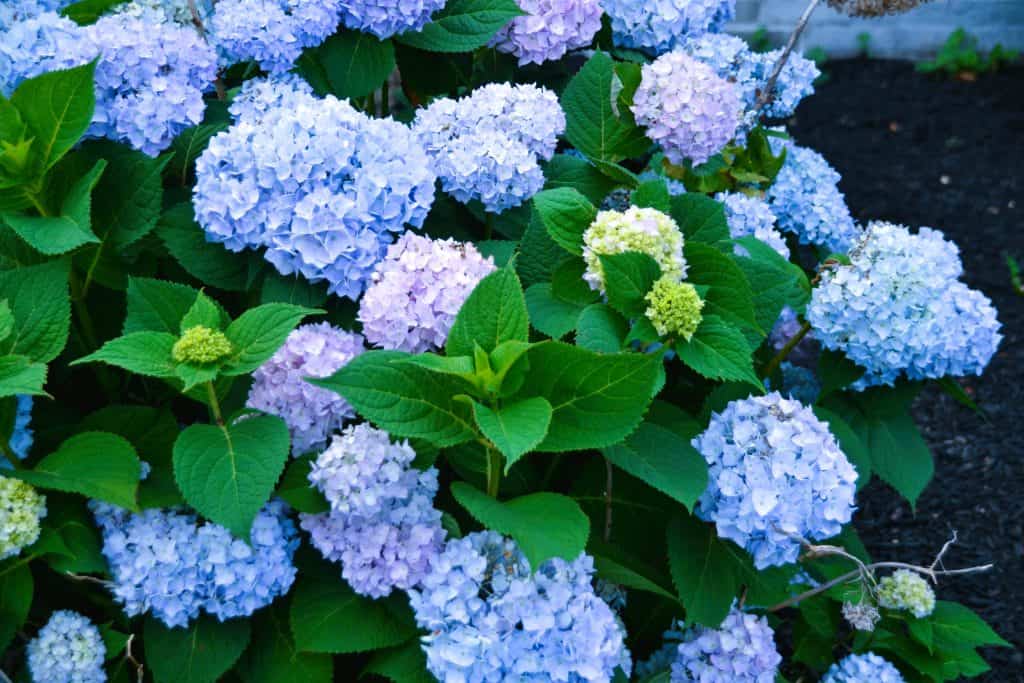Here’s what’s blooming in town this week to make your walks more enjoyable
By Laura Eisener
This past weekend was the Imperio Mariense celebration on Lynn Fells Parkway. The annual summer festival is just two years away from being a century old. The event included festive flower arrangements, including a charming flower arrangement in the gazebo featuring red gladiolus, anthurium, white baby’s breath (Gypsophila spp.), sky blue carnations (artificial color) and assorted greens, and others in the chapel, while red roses bloomed in the beds. Summer is certainly here.
The July full moon, often known as the Buck Moon, occurred last night. We have had some uncomfortably hot days this week, so I have gone out early to water whenever it did not rain.
It’s a good time to take a stroll around the gardens at the Saugus Iron Works. Dramatic tall spikes of white flowers on black cohosh (formerly Cimicifuga racemosa, now called Actaea racemosa) stand out against the dark walls of the house and shop. The beds around the house include coneflower (Echinacea spp. and hybrids) in many colors, bright yellow threadleaf tickseed (Coreopsis verticillata) and pale pink and cream common milkweed (Asclepias syriaca). The latter plant is the host for Monarch butterflies.
Blue hydrangeas are having another wonderful year, much like last year’s spectacular bloom season. Not all hydrangeas can produce blue flowers, but bigleaf hydrangea (Hydrangea macrophylla) and mountain hydrangea (Hydrangea serrata), both Asian species, will produce flowers that are blue if they are grown in acidic soil. The same plants, if the soil is alkaline or basic, will have pinkish flowers, and if the soil is neutral, may have purplish blossoms.
Every summer I am asked a lot of questions about hydrangeas, most often about why they are not blooming, but I don’t expect to hear much of that this summer. There will always be questions about color, especially when someone has bought a hydrangea because they loved the color, but the following year (or even sooner) the flowers opened in a different shade. In the nursery pot, the plant takes its color cues from the soil in that pot, but when the roots grow out into your own garden soil, the acidity in your soil is likely to be different so new flowers will likely be pinker or bluer than they were before. Limestone makes the soil sweeter, adding to the likelihood of pink flowers, and it can leach out of foundations (concrete contains limestone), white rocks added as a decorative touch in the garden, or lawn treatments to make the grass greener. Our natural soil in Saugus tends to be somewhat acidic due to granite bedrock, and that tends to bring out blue colors in bigleaf hydrangeas (Hydrangea macrophylla) and their hybrids.
The most common blue hydrangeas with a mophead-style flower cluster, also known as hortensia style, is ‘Endless Summer,’ which is a cross between a bigleaf hydrangea and a native North American species, smooth hydrangea (Hydrangea arborescens), which has white flowers. Up until that development, all blue flowering hydrangeas bloomed on “old wood,” which are branches produced in the previous growing season. If the winter was harsh, there might be no flowers produced the following summer. Smooth hydrangea could produce buds in the spring that would bloom in summer of the same year. Now most blue hydrangeas have these two species in their genetic background and are more likely to bloom almost every summer.
Some of the newest introductions in bigleaf hydrangeas have very dark, nearly black foliage. ‘Eclipse,’ a mophead-style hydrangea with very dark leaves, was produced by Spring Hill’s First Editions. The flowers will be dark purple in acidic soil and red in sweet (alkaline) soil.
Usually, the base of each petal is a little paler than the outer edges, so the flower cluster often looks two-toned. There is chlorophyll underlying the darker pigments, so the leaves do photosynthesize like most other plants, and the flowers are produced on both “old” and “new” wood so most years it will bloom for several months of the summer.
Occasionally the leaves will be greener if the plant is in deep shade, but so far I have not had much trouble with mine, and the leaves are still quite dark. Mine is still young, but they are likely to grow up to about 5′ tall, which makes them just a bit shorter than ‘Endless Summer.’ It is a dramatic looking shrub whether it is grown among other dark foliaged plants like purple leafed smoke bush (Cotinus coggygria atropurpurea) or purple leafed ninebark (Physocarpus opulifolius ‘Diabolo’) or used as a contrast to green foliage plants.
Editor’s Note: Laura Eisener is a landscape design consultant who helps homeowners with landscape design, plant selection and placement of trees and shrubs, as well as perennials. She is a member of the Saugus Garden Club and offered to write a series of articles about “what’s blooming in town” shortly after the outbreak of the COVID-19 pandemic. She was inspired after seeing so many people taking up walking.




